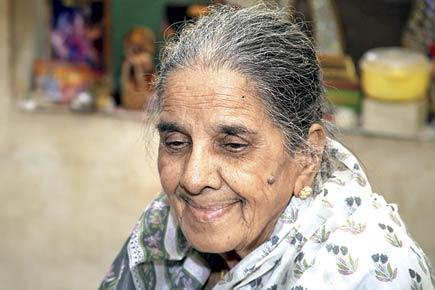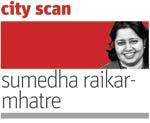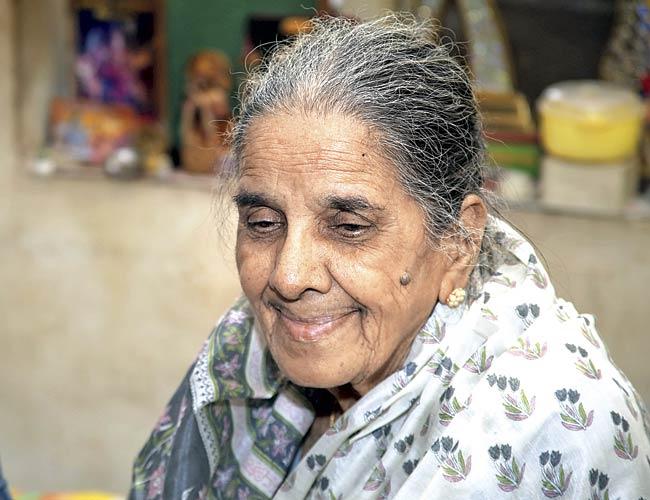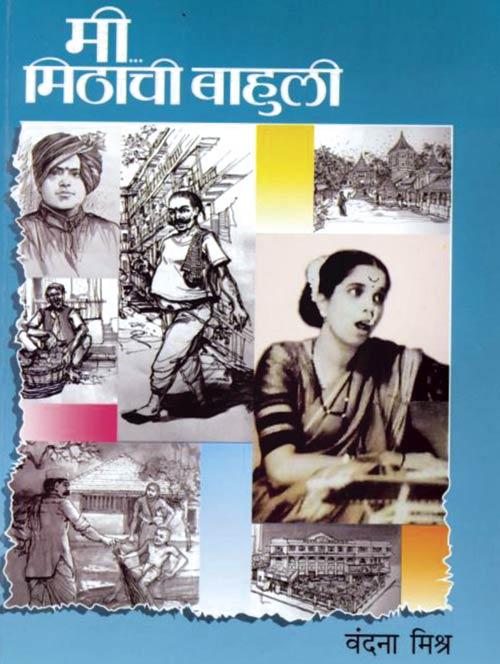An 88-year-old yesteryear actress travels back in time to the pre-Independence, pre-stainless steel, pre-electricity era in Mumbai. Her memoir Mee Mithachi Baahuli highlights a Marathi artiste’s stint in Gujarati and Marwadi theatre during the early 1940s

Early: 1943 Place: Roxy Cinema Film: Kismet
 The song Door Hato Aye Duniyawalon, Hindustan Hamara Hai ignites cinemagoers at Roxy for several months. Mumbaikars love the song as a vehicle to express the Quit India sentiment. The audience asks for adjustments of Kismet’s film reel to replay the patriotic number. Roxy management is happy to oblige.
The song Door Hato Aye Duniyawalon, Hindustan Hamara Hai ignites cinemagoers at Roxy for several months. Mumbaikars love the song as a vehicle to express the Quit India sentiment. The audience asks for adjustments of Kismet’s film reel to replay the patriotic number. Roxy management is happy to oblige.
ADVERTISEMENT

Vandana Mishra, dignity in theatre. Pic/Dushyant Bhatt
As the news of the song’s popularity reaches the government of Bombay, officials are sent to decode the potential hidden message against the British. Emissaries interrogate the film’s producers (Bombay Talkies) and its lyricist Pradeep.
After due deliberations, the British are made to understand that the song is directed against Hitler, Stalin and Japan. That saves the film from censorship. Kismet continues at Roxy and enthused patrons throw coins after every repeat of the cathartic Door Hato score.

Mee Mithachi Bahuli book cover
The above is one of the defining moments of Mumbai’s empathetic support to the Independence struggle. It is a part of the legendary history of Mumbai’s film industry and one of Bollywood’s biggest hits.
But the instance is also one of the joyous moments that infused colour in the life of a struggling, non-matriculate 16-year-old Marathi theatre actress who hoped for a better tomorrow. The Roxy-Kismet experience energised her life.
The actress Vandana Mishra, now an octagenarian (88) living in Borivali, with her journalist-son Ambarish Mishra, has recalled the Kismet episode in her recently-released memoir, Mee... Mithachi Baahuli.
The Marathi title translates as ‘I…A Salt Doll’, which refers to the 19th century philosopher Ramkrishna Paramhans’ parable of a salt doll that went to measure the depth of the ocean and dissolved in its deep water.
In the specific context of Mishra’s memories, the metaphor signifies the dissolution of the protagonist’s selfhood in the expansive ocean of Mumbai life.
Republic of Girgaum
Mee Mithachi Baahuli is an amusing tour of the bygone chawls which characterised Girgaum in the thirties and the forties. The writer (Sushila Lotlikar who became Vandana Mishra after marriage) calls upon the reader to devote all senses to the journey back in time.
Simple childhood joys like drinking Piyush (three paise per glass) near the municipal school at Lamington Road; thalipeeth aroma for the mid-day snacks; and jeera butter dipped in morning tea, evoke Mumbai’s working class past. The author’s mother, a young widowed nurse earning R 60 per month, chose a city that respected the working woman.
She became a part of Mumbai’s workforce and instilled a strong work ethic in her three children. Instead of leading a dependent life (with a tonsured head) steered by her in-laws in the Adivare village, she built four lives on the support and warmth of the neighbours in the Ramji Purshottam chawl. Mee Mithachi Baahuli is therefore a tribute to a city which made room for a resource-poor family.
It is a nuanced portrait of a city which provided a healthy cultural climate amid the mounting odds. Where else could the Lotlikar siblings have gotten legitimate social space for music classes, zhimma-phugdi community playtime, rangoli practicals, and the fun of collective radio listening? The Ganpati celebrations offered platforms for classical music mehfils of greats like Hirabai Badodekar, Gangubai Hangal and Kesarbai Kerkar.
Outside the classroom
Mee Mithachi Bahuli is not a mere excursion of old Girgaum, but it is an introduction to some generous Mumbaikars who believed in comradeship. Be it the chawl owner who waived the house rent or the doctor who gave free Waterbury’s Compound, Mumbai was graced with friendly people who helped the dispossessed.
Though the author (Sushila) had to leave her schooling mid-way to support the family, she was fortunate to be inducted in noted thespian Parshvnath Altekar’s Little Theatre group which further gave her access to another avant-garde theatreperson, Mama Varerkar.
Both shaped her appreciation and receptivity towards the performing arts. Altekar wanted women to take on the lead roles on stage. He thought the audience deserved a refreshing change from the era of long-winding musicals with men playing women’s roles. Mindful of the impact of cinema on the Indian mind, he advocated a new form of socially-relevant theatre.
Similarly, playwright Varerkar supported a feminist and gender-sensitive theatre. His experimental play Saraswat, in which the author played her first stage role (1942), was an educational experience. To be able to perform the off-beat progressive play in a fully packed commercial theatre of Royal Opera House (Girgaum) was a life-altering moment.
Way of life
In Mee Mithachi Baahuli, the professional and personal choices made by the author characterise the Mumbai way of life. Sushila Lotlikar, a girl brought up in a Saraswat Brahmin Marathi family, undergoes several transformations to suit the demands of time.
She changes her ‘Konkani’ twang to get into chaste Marathi plays. She adapts to the rigour of shows, rehearsals and travelling theatre. For better monetary returns, she takes to Gujarati and Marwadi theatre, for which she learns the languages and renders convincing roles in non-Marathi milieus.
At the age of 20, she marries a Hindi writer Pandit Jaydev Mishra and adopts North-Indian family traditions. She renounces her short but eventful theatre career and becomes a full-time homemaker and mother.
She comes back to Marathi theatre 22 years later, this time as a paid artiste of the Natyaniketan theatre company, headquartered in the famous heritage precinct of Khotachiwadi. At every juncture, the book underlines the independence granted to the individual by the city. Mumbai emerges as an ally in the author’s endeavours.
Mumbai and pluralism
Mee Mithachi Baahuli is a validation of the Gujarati and Marwadi language theatre streams that flowed in the city. The journey of the Gujarati theatre company, Shree Deshi Natak Samaj makes a motivating read for anyone proud of Mumbai’s pluralism.
The company catered to the entertainment needs of Mumbai’s Gujarati businessmen and entrepreneurs. It owned a 700 seater auditorium in Kalbadevi, ensuring a rightful performance space throughout the year. Most of the plays were light-hearted, and almost each one had a Garba dance sequence!
The Marwadi plays were a shade different, but they were performed in the same Shree Deshi Natak Samaj auditorium. That occasionally caused a conflict of interest, especially when superhit Marwadi plays like Ramu Chanana spanned for two years.
The author played the heroine in this romantic musical folk tale in which lovers commit suicide because their relationship does not fit the demands of a caste-ridden society. The songs in the play elicited ‘once more’ responses, even the one after the lovers’ death.
That caused a lot of unintended humour because the ‘once mores’ required the ‘dead’ actors to get up and sing again. As the author recalls, when veteran director Prithvi Raj Kapoor watched the play, he joked about the ‘circus’ in it.
He asked the author to work in Hindi plays at Prithvi Theatre an offer she could not accept due to Ramu Chanana’s demanding schedule. Mee Mithachi Baahuli reminds the reader of Mumbai’s multi-hued assimilative theatre history.
This history should be archived because the work done in Gujarati, Hindi and Marwadi theatre of the 1940s provides the backdrop for the city's contemporary theatre practices. The tenacity to practice theatre despite odds is a Mumbai trait. The past practitioners shaped the city and gave it a proud legacy of theatre experimentation.
Second Coming
The book deserves an English translation and a rendering in Gujarati too. It is a thought-provoking read, particularly when Maharashtra is besieged by narrow, regional politics.
At a time when “speaking Marathi” and “being Maharashtrian” assumes political colour, Sushila Lotlikar (alias Vandana Mishra) affirms the importance of enriching Marathi by embracing new cultures and languages.
Very unlike the political voices who feel the need to prove their ‘Marathi’ identity by way of high-decibel festive spectacles, the author makes a case for quiet observances. Despite being anchored in the past, she is no champion of fanatic rituals and traditions or overt religious pride.
She respects religious faith, but after appreciating the distinction between the private and the public realm in the matters of belief. Such a reasonable Marathi voice should cross over to other regional literatures.
It is these subaltern voices that enrich the public discourse; they offset the din of rabid conservatives who claim to represent Maharashtra. Mishra’s memoir can supplement the literature chronicling Mumbai, but only after an improved second edition sparkles with judicious editing and better typographical regulation.
At this point, it seems that her manuscript travelled to the Rajhans printing press in Pune without a stopover at the editing department. Refined production support could have been provided by a publishing house with six decades in the business. Dolls need to be handled with care and sophistication.
Sumedha Raikar-Mhatre is a Mumbai-based cultural chronicler.
 Subscribe today by clicking the link and stay updated with the latest news!" Click here!
Subscribe today by clicking the link and stay updated with the latest news!" Click here!







